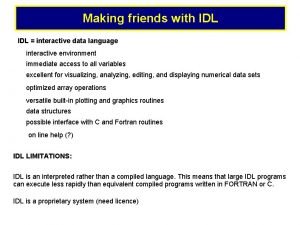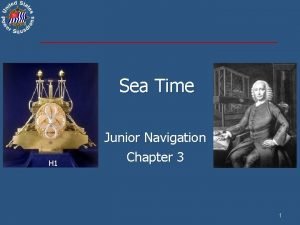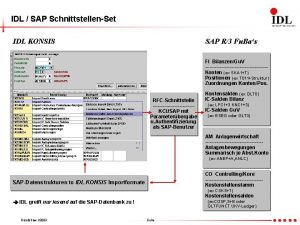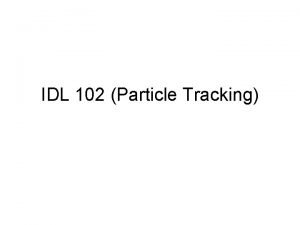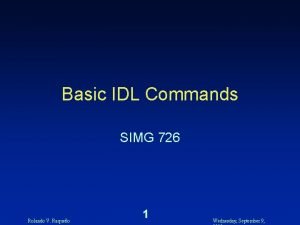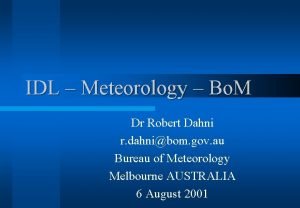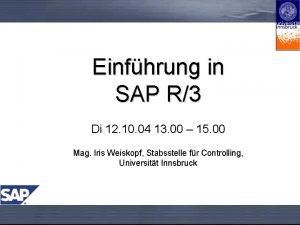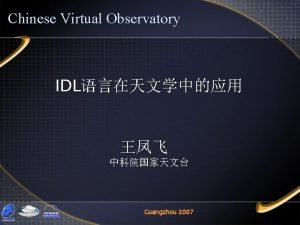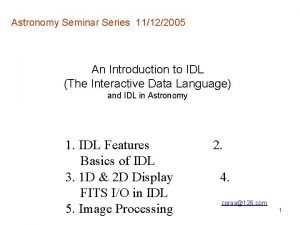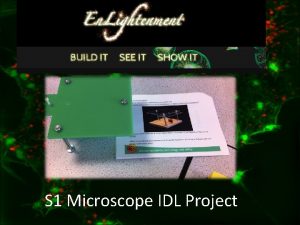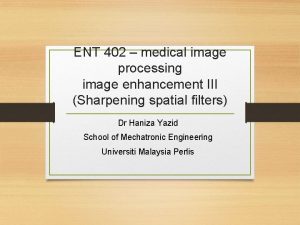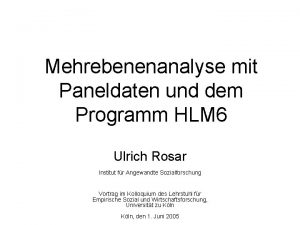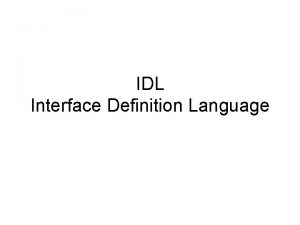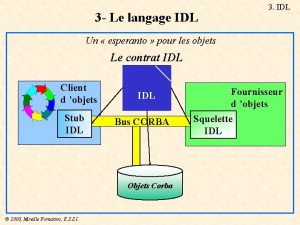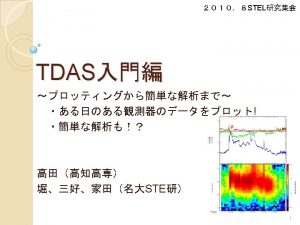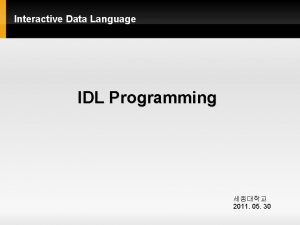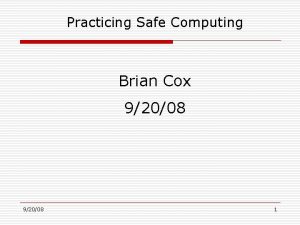Learning and Practicing Interactive Data Language IDL to

























- Slides: 25

Learning and Practicing Interactive Data Language (IDL) to Manipulate Scientific Data 2007 -2008 IDL Grid Team Mentor: Dr. Minjun Wang Wanda-Marie Carey Brittnei Teasley Jamika Baltrop Chelsea Vick

Objectives • Introductions • Abstract • Purpose • Conclusion • Future work • Acknowledgements

Abstract • • The Center for Remote Sensing of Ice Sheets (CRESIS) headed at the University of Kansas (KU) was funded by the National Science Foundation (NSF) to explore the Polar Regions (Greenland Antarctica), and research the various changes occurring with ice sheets. CRe. SIS uses various types of radar to analyze ice sheet data. Researchers use radar to probe the ice sheets to get huge amounts of data- Synthetic Aperture Radar (SAR) data. SAR data contains more information on the ice sheets for discovery. During the International Polar Year (IPY 2007 -2009), luminous data sets will be obtained- Terabytes of data will be in just one field campaign. This means large storage devices and fast computers (multi-core) will be needed to process the data sets and retrieve results in a timely manner, which will outstrip the current capacity of the grids of storage and computers. In response, Indiana University (IU), Elizabeth City State University (ECSU), and the University of Kansas (KU) initiated a Polar Grid project for the purpose to set up a Cyber – Infrastructure for Remote Sensing of Ice Sheets. This Grid will consist of the state-of-theart computers and storage hardware, and also application/processing tools, and scientific gateways for the Polar Science Community to conveniently access the resources. It is important, too, to educate and train the researches, educators, and students for polar science. The Center of Excellence in Remote Sensing Education and Research (CERSER) of ECSU has committed to engage the students and train them for polar science with hand-on practices and skills for future study, research and career dedications to the polar science field.

Abstract To provide support for Polar data collection, an advanced scientific programming and visualization environment will be used to develop interfaces for computation and visualization- computer-intensive tasks such as in big array operations. In this project, Interactive Data Language (IDL) was investigated as the package for efficient and convenient data visualization capacities in the forms of graphics, images and photographs. 2 D and 3 D images require intensive computation and efficient visualization, which are crucial for the Polar Grid project. The project involved learning the IDL language and environment. IDL is an array-oriented data analysis and visualization application, which is widely used in research, commerce, and education. Its application areas include engineering, medical physics, astronomical, space, and earth science. It offers rapid interactive data analysis and visualization, a programming environment, and end user applications. IDL is available for Windows, UNIX, Linux, Macintosh and VMS platforms and Operating Systems. The high availability facilitates data analysis and visualization in multi-platform environment, and ensures high code portability among platforms and systems.

Purpose • The original purpose of CERSER was to conduct research on oceans and coastal processes. However, Dr. Hayden (ECSU) has a partnership with the University of Kansas and Indiana University. As a result of their partnership they have received money to conduct research on ice sheets in Greenland Antarctica. One of the ways they conduct research is to gather information from the Synthetic Aperture Radar (SAR). Because the data files are so large they need large storage spaces and computers that are fast and equipped for handling large datasets. Because of this problem the Polar Grid Project was established with the purpose of creating a Cyber-Infrastructure for the Remote Sensing of Ice Sheets. The goal of the project is to establish a grid that will be used for advanced computing, storage, and applications and processing. The grid will also be a convenient way for people that need the data to have access to it.

Getting Started Online tutorials – Used IDL to Manipulate and Visualize Scientific Data • Variables and Arithmetic • Matrices • Imaging

Tutorials • These tutorials helped us to do examples of setting scalar (variable with only magnitude), vector, and array variables, as well as performing some basic operations. They also allowed us to copy programs and data from the example directories into our own , and modify the programs and data so we could try out different features of IDL.

Interactive Data Language (IDL) • General purpose scientific computing package which provides a suite of mathematical functions, data analysis tools, as well as some scientific visualization and animation tools. • Uses a command line interface

Two modes in IDL • Interactive- allows you to rapidly analyze and visualize data using concise and efficient single-line commands (simple) execute by pressing Enter • Compiled- allows you to create more complex applications for analyzing and visualizing data edit, compile, execute

Interactive Mode Example • This is to create a sine wave plot • IDL> x = findgen(201) * 0. 1 • IDL> y = sin(x) • IDL> plot, x, y


Sine Wave plot • Floating array created with 201 elements where • • the first element is equal to 0. 0, the last 20. 0, and the interval between elements is equal to 0. 1 Then a second floating-point array (y) is created, where elements are equal to the sine of the corresponding elements in the first array. The two arrays are plotted on a two-dimensional line plot.

Compiled Mode example • Sequences of IDL statements are formed into • programs that are edited, compiled, and executed. You must first save in the file named hello. pro following the path c: rsiidl 63examples IDL > print, ‘Hello world’ IDL > map_set, /continents, /grid IDL >. compile hello. pro IDL > hello


Outputting Variables and Arithmetic • IDL > x = 4. 0 • IDL > y = 2. 5 • IDL > z = x + y • IDL > w = x^y + sin(z) • IDL > print, x, y, z, w 4 2. 50000 6. 50000 32. 2151


Matrices • A matrix is a rectangular table of elements (or entries), • • • which may be numbers or, more generally, any abstract quantities that can be added and multiplied Matrices are used to describe linear equations, keep track of the coefficients of linear transformations and to record data that depend on multiple parameters. Matrices are described by the field of matrix theory. Matrices can be added, multiplied, and decomposed in various ways, which also makes them a key concept in the field of linear algebra.

Outputting Matrices IDL> A = dblarr(2, 4) IDL> for i = 0, 1 do begin $ IDL> for j = 0, 3 do begin $ IDL> a(i, j) = 10 * i + j IDL> print, A


Image Basics • Images have already been preloaded into the computer • We enter the path in which the image is saved IDL >nyny=read_tiff( ‘c: rsiidl 63examplesdataimage. tif’)

Displaying Image TV procedure writes an array to the display as an image without scaling • tv, nyny To dismiss graphics shown enter wdelete


Future Work • Continue to work on creating the Cyber- • Infrastructure for the Remote Sensing of Ice Sheets, and establishing a grid for usage of advanced computing, applications and processing, and storage. Create two interfaces. - One interface will be used to demonstrate how to perform computations using an array. -The other interface is to visualize the data in the form of a graphic, image or photograph.

Future Work continued Interface • API Application Programming Interface library of functions Example - when you open your Viking email box instead of typing a series of commands, you can simply use the menus and icons to send and retrieve your mail.

Acknowledgements • Dr. Linda B. Hayden • Dr. Minjun Wang
 Idl interactive data language
Idl interactive data language Stage 27 practicing the language answers
Stage 27 practicing the language answers 180 longitude
180 longitude New day and date always begins in the _________ of idl
New day and date always begins in the _________ of idl Practicing healthful behaviors
Practicing healthful behaviors Chapter 8 lesson 3 practicing abstinence
Chapter 8 lesson 3 practicing abstinence Practicing design
Practicing design Ddl practice questions
Ddl practice questions The life skill using community resources means
The life skill using community resources means Practicing discernment
Practicing discernment Idl
Idl Idl fft
Idl fft Corba introduction
Corba introduction Idl konsis
Idl konsis Idl tracking
Idl tracking Franca idl
Franca idl Idl polyfill
Idl polyfill Robert idl
Robert idl Idl konsis handbuch
Idl konsis handbuch Mwrfits
Mwrfits 11122005 colour
11122005 colour Df=idl xb
Df=idl xb Idl projects
Idl projects Combining spatial enhancement methods
Combining spatial enhancement methods Idl hotline
Idl hotline Idl tvrd
Idl tvrd
